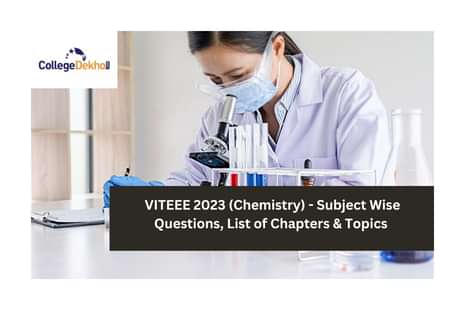Atomic Structure | - Bohr’s atomic model-Sommerfeld’s extension of atomic structure; Electronic configuration and Quantum numbers; Shapes of s, p, d, f orbitals - Pauli’s exclusion principle - Hund’s Rule of maximum multiplicity- Aufbau principle
- Emission and absorption spectra, line and band spectra; Hydrogen spectrum - Lyman, Balmer, Paschen, Brackett and Pfund series; de Broglie’s theory; Heisenberg’s uncertainty principle - wave nature of electron - Schrodinger wave equation (No derivation)
- Eigen values and eigen functions. Chemical bonding and hybridization of atomic orbitals involving s, p and d orbitals
|
Thermodynamics, Chemical Equilibrium and Chemical Kinetics - I and II | - Laws of thermodynamics - spontaneous and non-spontaneous processes, entropy, Gibb’s free energy - Standard Gibbs free energy change (ΔG0 ) and chemical equilibrium - significance of entropy.
- Rate of a chemical reaction, factors affecting rates of reaction: concentration, temperature, pressure and catalyst; Law of mass action - Le Chatelier’s principle, applications of chemical equilibrium
- Rate expression, order, and molecularity of reactions, zero order, first order and pseudo first order reaction - half-life period
- Determination of rate constant and order of reaction. Temperature dependence of rate constant - Arrhenius equation, activation energy and its calculation; elementary concept of collision theory of bimolecular gaseous reactions
|
Solutions | - Colligative properties of dilute solutions; Different methods for expressing the concentration of solution - molality, molarity, mole fraction, percentage, the vapour pressure of solutions and Raoult's Law - Ideal and non-ideal solutions, vapour pressure - composition, plots for ideal and non-ideal solutions
|
The s-block elements | - Properties and chemical reactivity of alkali and alkaline earth metals
|
The p-block elements | - Phosphorous compounds: PCl3, PCl5 - Oxides, Hydrogen halides, Inter-halogen compounds and Xenon fluoride compounds
|
General characteristics of d - block elements | - Electronic Configuration - Oxidation states of first row transition elements and their colours
- Occurrence and principles of extraction: Copper, Silver, Gold and Zinc
- Preparation and properties of CuSO4, AgNO3and K2Cr2O7
|
Lanthanides | - Introduction, electronic configuration, general characteristics, oxidation state - lanthanide contraction, uses, brief comparison of Lanthanides and Actinides
|
Introduction to coordination chemistry | - IUPAC nomenclature of mononuclear coordination compounds; Isomerism, Geometrical isomerism in 4-coordinate, 6-coordinate complexes
- Theories on coordination compounds - Werner’s theory (brief), Valence Bond theory
- Uses of coordination compounds. Bioinorganic compounds (Haemoglobin and chlorophyll)
|
Solid-State Chemistry | - Lattice - unit cell, systems, types of crystals, packing in solids; Ionic crystals - Imperfections in solids - point defects, X-Ray diffraction - Electrical Property, Amorphous solids (elementary ideas only)
|
Surface Chemistry | - Adsorption- physisorption and chemisorption; Catalysis - homogeneous and heterogeneous catalysis
|
Electrochemistry | - Redox reactions; Theory of electrical conductance; metallic and electrolytic conductance.
- Faraday’s laws - theory of strong electrolytes - Specific resistance, specific conductance, equivalent and molar conductance - Variation of conductance with dilution - Kohlrausch’s Law - Ionic product of water, pH, and pH- buffer solutions - use of pH values.
- Cells - Electrodes and electrode potentials - construction of cell, EMF values and standard electrode potentials, Nernst equation and its application to chemical cells.
- Relation between Gibbs energy change and EMF of a cell, dry cell, electrolytic cells and Galvanic cells; lead accumulator; Fuel cells, Corrosion, and its prevention.
|
Environmental Chemistry | Environmental pollution - Atmospheric, water and soil |
Carbon | - Tetravalency, hybridization; Classification of organic compounds - functional groups; Homologous series; Nomenclature (IUPAC); Homolytic and heterolytic bond cleavage; carbocations, carbanions and free radicals; electrophiles and nucleophiles; Inductive effect, electromeric effect, resonance and hyperconjugation.
- Common organic reactions - Substitution, addition, elimination and rearrangement Isomerism in Organic Compounds: Definition, Classification - structural isomerism, stereo isomerism - geometrical and optical isomerism.
- Optical activity - chirality - compounds containing chiral centres - R, S notation, D, L notation.
- Detection of the functional groups in organic compounds: Hydroxyl (alcoholic and phenolic), carbonyl (aldehyde and ketones) carboxyl and amino groups.
|
Common organic reactions | - Substitution, addition, elimination and rearrangement
|
Isomerism in Organic Compounds | - Definition, Classification - structural isomerism, stereo isomerism - geometrical and optical isomerism.
- Optical activity - chirality - compounds containing chiral centres - R, S notation, D, L notation.
|
Detection of the functional groups in organic compounds | Hydroxyl (alcoholic and phenolic), carbonyl (aldehyde and ketones) carboxyl and amino groups. |
Alcohols and Ethers | - Nomenclature of alcohols - Classification of alcohols - distinction between 1°, 2° and 3° alcohols - General methods of preparation of primary alcohols, properties
- Methods of preparation of dihydric alcohols: Glycol - Properties - Uses. Methods of preparation of trihydric alcohols - Properties - Uses
- Aromatic alcohols - preparation and properties of phenols and benzyl alcohol; Ethers - Nomenclature of ethers - general methods of preparation of aliphatic ethers - Properties - Uses. Aromatic ethers - Preparation of Anisole - Uses
|
Carbonyl Compounds | - Nomenclature of carbonyl compounds - Comparison of aldehydes and ketones.
- General methods of preparation of aldehydes - Properties - Uses. Aromatic aldehydes - Preparation of benzaldehyde - Properties and Uses
- Ketones - general methods of preparation of aliphatic ketones (acetone) - Properties - Uses.
- Aromatic ketones - preparation of acetophenone - Properties - Uses, preparation of benzophenone - Properties.
- Name reactions; Clemmensen reduction, Wolff - Kishner reduction, Cannizzaro reaction, Claisen Schmidt reaction, Benzoin Condensation, Aldol Condensation
- Preparation and applications of Grignard reagents.
|
Carboxylic Acids and their derivatives | - Nomenclature - Preparation of aliphatic monocarboxylic acids - formic acid - Properties - Uses.
- Monohydroxy mono carboxylic acids; Lactic acid - Synthesis of lactic acid.
- Aliphatic dicarboxylic acids; Preparation of oxalic and succinic acids.
- Aromatic acids: Benzoic and Salicylic acids - Properties - Uses.
- Derivatives of carboxylic acids; acetyl chloride (CH3COCl) - Preparation - Properties - Uses
- Preparation of acetamide, Properties - acetic anhydride - Preparation, Properties. Preparation of esters - methyl acetate - Properties
|
Organic Nitrogen Compounds Organic Nitrogen Compounds | - Aliphatic nitro compounds - Preparation of aliphatic nitroalkanes - Properties - Uses.
- Aromatic nitro compounds - Preparation - Properties - Uses.
- Distinction between aliphatic and aromatic nitro compounds.
- Amines; aliphatic amines - General methods of preparation - Properties - Distinction between 1°, 2° and 3°amines.
- Aromatic amines - Synthesis of benzylamine - Properties, Aniline - Preparation - Properties - Uses.
- Differences between aliphatic and aromatic amines. Aliphatic nitriles - Preparation - properties - Uses.
- Diazonium salts - Preparation of benzene diazonium chloride - Properties.
|
Biomolecules and Polymers | - Carbohydrates – Distinction between sugars and non-sugars, structural formulae of glucose, fructose, and sucrose, with their linkages, invert sugar – definition, examples of oligo and polysaccharides
- Amino acids and Proteins – Classification of amino acids with examples, Peptides - properties of peptide bond;
- Proteins - primary, secondary, tertiary and quaternary structure (qualitative idea only), denaturation of proteins, enzymes
- Lipids - Definition, classification with examples, difference between fats, oils, and waxes.
- Nucleic acids – Chemical constitution of DNA and RNA Polymers - Classification – Natural and synthetic, methods of polymerization (addition and condensation), copolymerization.
- Some important polymers: natural and synthetic like polythene, nylon, polyesters, Bakelite, rubber. Biodegradable and non-biodegradable polymers.
|


















Similar Articles
BITSAT Test Centre Allotment 2024: Exam City, Dates, Slot Booking Process
BITSAT Slot Booking 2024 - Book Test Date & Slot
BITSAT Exam Centers 2024- Check List of Test Cities Here
BITSAT Test Centre Allotment 2024: Release Date, Exam City, Slot Booking Process
What is a Good Score & Rank in VITEEE 2024?
VITEEE 2024 Rank vs Branch Analysis